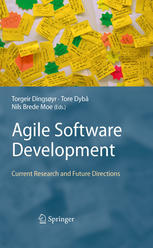

Most ebook files are in PDF format, so you can easily read them using various software such as Foxit Reader or directly on the Google Chrome browser.
Some ebook files are released by publishers in other formats such as .awz, .mobi, .epub, .fb2, etc. You may need to install specific software to read these formats on mobile/PC, such as Calibre.
Please read the tutorial at this link: https://ebookbell.com/faq
We offer FREE conversion to the popular formats you request; however, this may take some time. Therefore, right after payment, please email us, and we will try to provide the service as quickly as possible.
For some exceptional file formats or broken links (if any), please refrain from opening any disputes. Instead, email us first, and we will try to assist within a maximum of 6 hours.
EbookBell Team

0.0
0 reviewsAgile software development has become an umbrella term for a number of changes in how software developers plan and coordinate their work, how they communicate with customers and external stakeholders, and how software development is organized in small, medium, and large companies, from the telecom and healthcare sectors to games and interactive media. Still, after a decade of research, agile software development is the source of continued debate due to its multifaceted nature and insufficient synthesis of research results. Dingsøyr, Dybå, and Moe now present a comprehensive snapshot of the knowledge gained over many years of research by those working closely with or in the industry. It shows the current state of research on agile software development through an introduction and ten invited contributions on the main research fields, each written by renowned experts. These chapters cover three main issues: foundations and background of agile development, agile methods in practice, and principal challenges and new frontiers. They show the important results in each subfield, and in addition they explain what these results mean to practitioners as well as for future research in the field. The book is aimed at reflective practitioners and researchers alike, and it also can serve as the basis for graduate courses at universities.